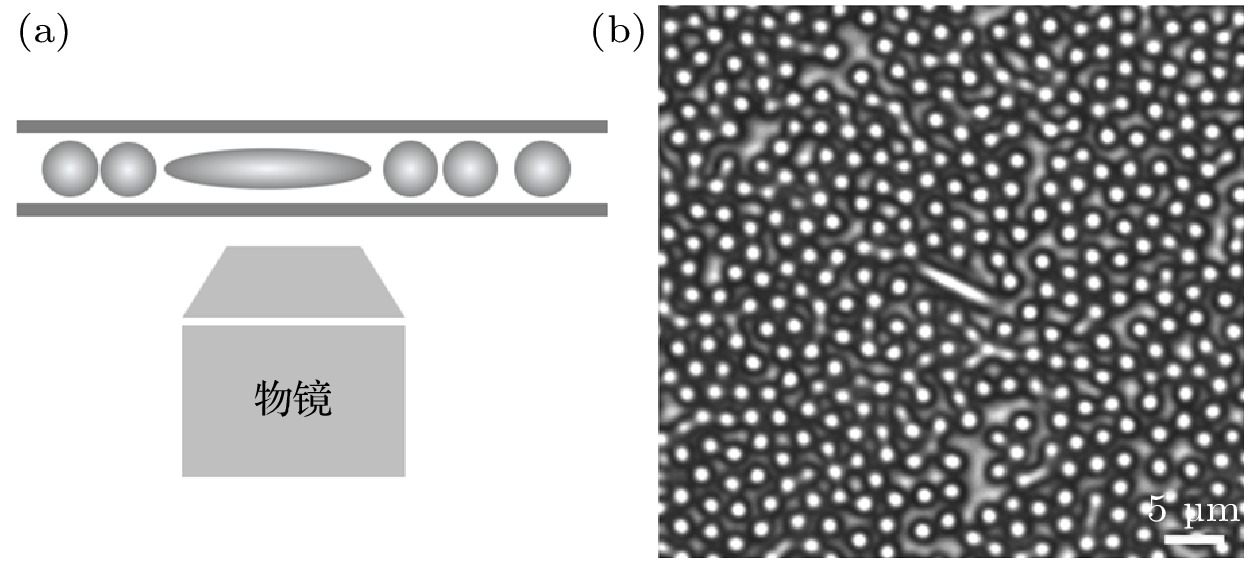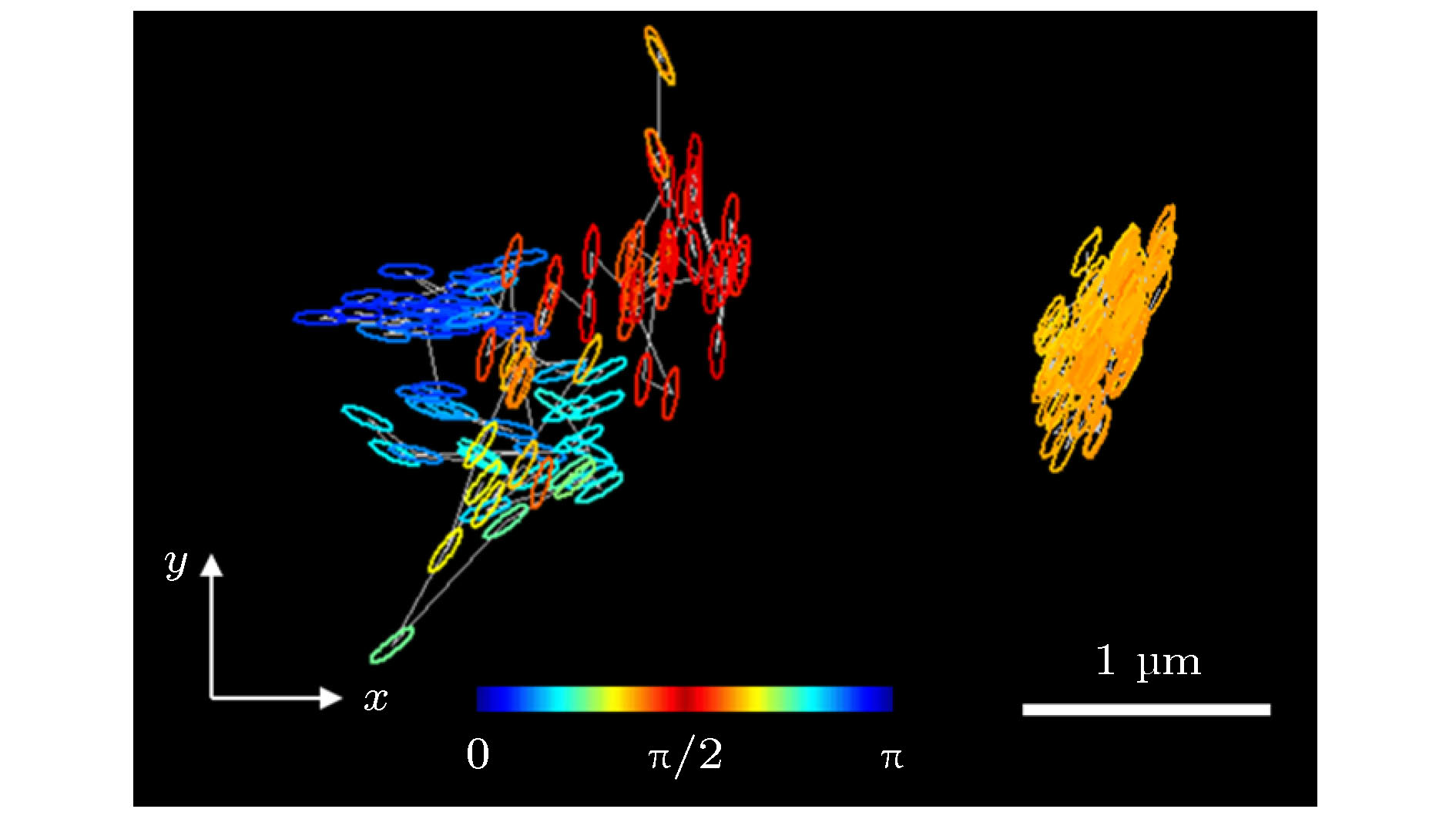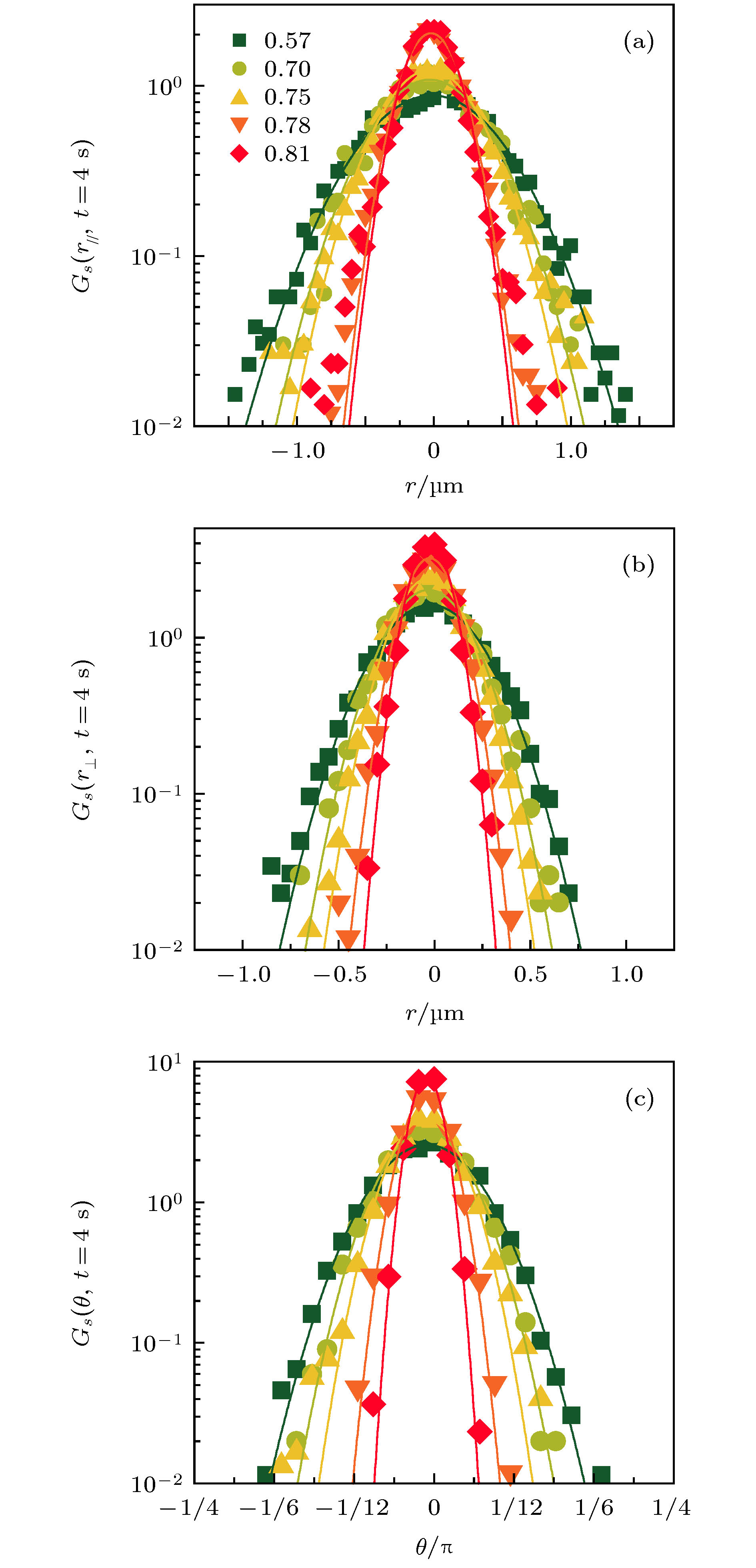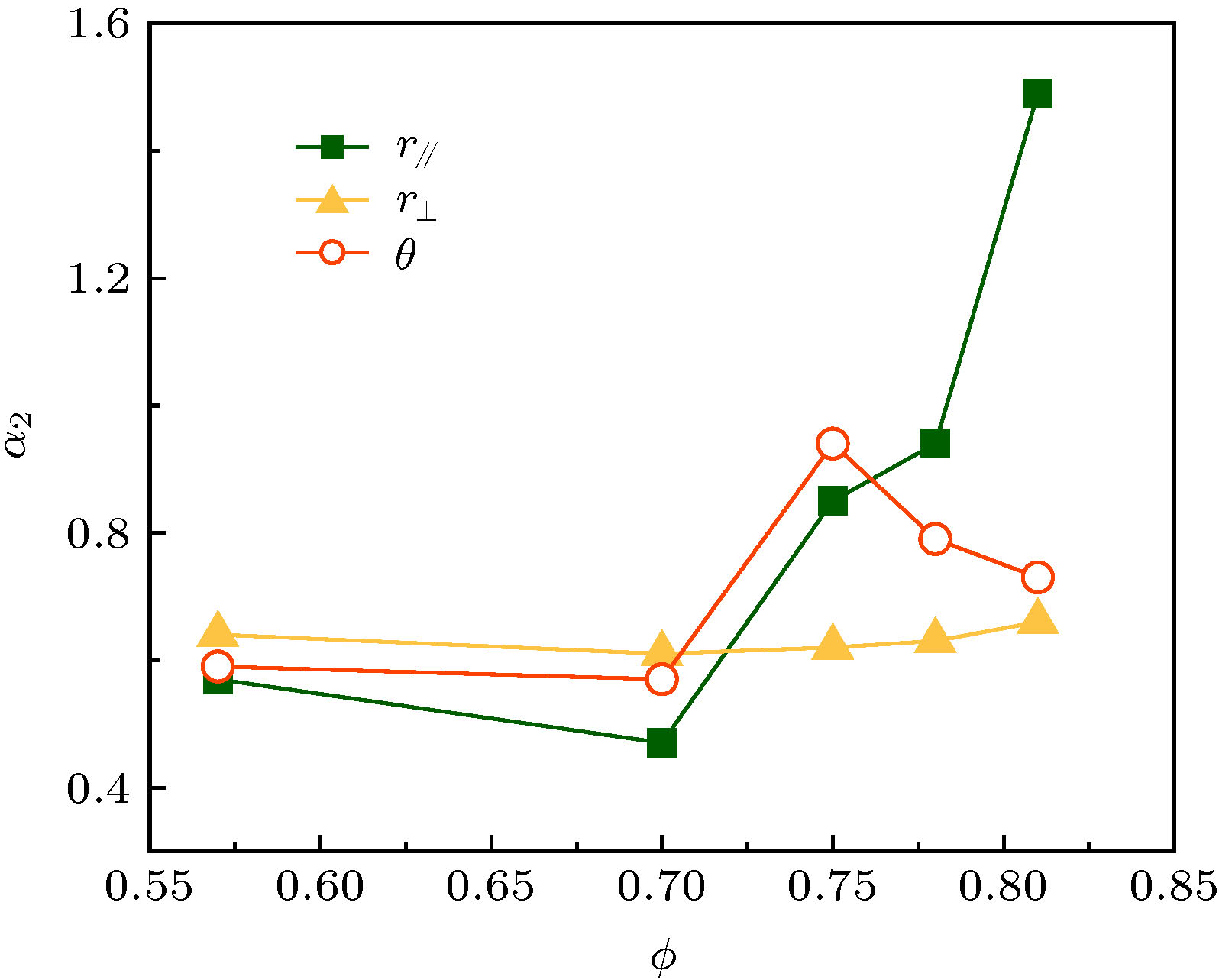-
复杂受限介质中的扩散行为在自然界是普遍存在的, 与其相关的研究涉及物理学、材料科学和生物学等多学科领域, 受到了这些领域研究者们的广泛关注. 然而, 相比于众多的圆球受限扩散研究, 对形状各向异性的粒子在复杂受限介质中的扩散行为的研究依然比较匮乏. 本文提出了一个简单的软物质实验模型—胶体椭球与圆球混合体系, 来研究形状各向异性的椭球在圆球的受限环境下的扩散行为. 通过描述椭球的运动轨迹和计算粒子的均方位移、范霍夫自关联函数以及非高斯参量, 发现随着圆球浓度的增大, 椭球的平动和转动都被抑制, 出现次扩散行为; 并且, 平动和转动的位移分布也展现出不同的演化行为, 表明这两种运动在高浓度下会发生解耦合. 此外, 在不同圆球浓度下, 椭球都趋向于沿自身长轴方向扩散, 因此在沿长轴和短轴方向的平动受到的受限作用的影响也不同, 导致二者也发生解耦合行为. 综上所述, 受限环境会导致各向异性胶体粒子出现反常扩散行为. 本文的研究有助于理解复杂环境中各向异性物体的扩散和输运行为.The diffusive transport in complex confined media is ubiquitous such as diffusions of micro- or nano-particles in glassy liquids and polymer solutions, protein diffusions under crowded conditions, and deliveries of drugs in the biological media. Therefore, the understanding of the diffusive transport arouses the great interest of researchers in the physics, materials science, and biology circles. Despite the fact that the shape of the colloidal particles acts as one of the important physical factors influencing their dynamic behaviors, the study of the anisotropic particles diffusing in confined media is still lacking. In this work, we propose a simple experimental model to investigate the confined diffusion of shape-anisotropic particles. The diffusion of an ellipsoid at different area fractions (ϕ) of colloidal spheres is investigated through video microscopy. At low ϕ, ellipsoid exhibits a random trajectory and free diffusion in translational and rotational degree of freedom; while at high ϕ, the trajectory is in a small spatial range with a nearly constant orientation of the particle, indicating that the arrested diffusion takes place in translational and rotational degree of freedom. The translational and rotational mean square displacement decrease with the increase of ϕ. By power-law fitting (~tβ), it is found that β decreases from 1 to a small value at high ϕ, demonstrating that the ellipsoid experiences a transition from normal diffusion to sub-diffusion. Moreover, β for rotational motion decreases faster than that for translational motion at high ϕ, which signifies that the the rotational motion decouples from the translational motion with increasing ϕ. The results from the van Hove correlation function show that the translational displacement along the major axis of the ellipsoid is always larger than that along the minor axis, manifesting the ellipsoid prefers to diffuse along its major axis independent of ϕ. Significant non-Gaussian tail is observed in the distribution of the translational displacement along the major axis with increasing ϕ. However, the distribution of the translational displacement along the minor axis presents a nearly Gaussian behavior independent of ϕ. This indicates that the translational motion along the major axis decouples from the translational motion along the minor with increasing ϕ. For the rotational displacement, the non-Gaussian tail is only observed at the intermediate ϕ. These non-Gaussian behaviors are confirmed by calculating the non-Gaussian parameter (α2). Our experiments demonstrate that the confinements give rise to the anomalous diffusion behaviors of the anisotropic colloids, which is conducive to the understanding of transportations of anisotropic objects in complex environments.
-
Keywords:
- colloids /
- diffusion /
- ellipsoid /
- non-Gaussian distribution /
- dynamics
[1] Wang Y, Benton L A, Singh V, Pielak G J 2012 J. Phys. Chem. Lett. 3 2703
 Google Scholar
Google Scholar
[2] Grimaldo M, Lopez H, Beck C, Roosen R F, Moulin M, Devos J M, Laux V, Hartlein M, Da Vela S, Schweins R, Mariani A, Zhang F, Barrat J L, Oettel M, Forsyth V T, Seydel T, Schreiber F 2019 J. Phys. Chem. Lett. 10 1709
 Google Scholar
Google Scholar
[3] Edmond K V, Elsesser M T, Hunter G L, Pine D J, Weeks E R 2012 P. Natl. Acad. Sci. U.S.A. 109 17891
 Google Scholar
Google Scholar
[4] Sentjabrskaja T, Zaccarelli E, De Michele C, Sciortino F, Tartaglia P, Voigtmann T, Egelhaaf S U, Laurati M 2016 Nat. Commun. 7 11133
 Google Scholar
Google Scholar
[5] Xue C, Zheng X, Chen K, Tian Y, Hu G 2016 J. Phys. Chem. Lett. 7 514
 Google Scholar
Google Scholar
[6] Wang X, Chen Y, Xue L, Pothayee N, Zhang R, Riffle J S, Reineke T M, Madsen L A 2014 J. Phys. Chem. Lett. 5 3825
 Google Scholar
Google Scholar
[7] Geng Y, Dalhaimer P, Cai S, Tsai R, Tewari M, Minko T, Discher D E 2007 Nat. Nanotechnol. 2 249
 Google Scholar
Google Scholar
[8] Mitragotri S, Lahann J 2009 Nat. Mater. 8 15
 Google Scholar
Google Scholar
[9] Hnggi P, Marchesoni F 2009 Rev. Mod. Phys. 81 387
 Google Scholar
Google Scholar
[10] Zhou H X, Rivas G, Minton A P 2008 Annu. Rev. Biophys. 37 375
 Google Scholar
Google Scholar
[11] Weeks E R, Crocker J C, Levitt A C, Schofield A, Weitz D A 2000 Science 287 627
 Google Scholar
Google Scholar
[12] Chen J X, Chen Y G, Ma Y Q 2016 Soft Matter 12 1876
 Google Scholar
Google Scholar
[13] Chen J X, Zhu J X, Ma Y Q, Cao J S 2014 Epl-Europhys. Lett. 106 18003
 Google Scholar
Google Scholar
[14] Glotzer S C, Solomon M J 2007 Nat. Mater. 16 557
 Google Scholar
Google Scholar
[15] Champion J A, Katare Y K, Mitragotri S 2007 P. Natl. Acad. Sci. U.S.A. 104 11901
 Google Scholar
Google Scholar
[16] Han Y, Alsayed A M, Nobili M, Zhang J, Lubensky T C, Yodh A G 2006 Science 314 626
 Google Scholar
Google Scholar
[17] Chakrabarty A, Konya A, Wang F, Selinger J V, Sun K, Wei Q H 2013 Phys. Rev. Lett. 111 160603
 Google Scholar
Google Scholar
[18] Moreno A J, Kob W 2004 AIP Conference Proceedings 708 576
 Google Scholar
Google Scholar
[19] Kim J, Sung B J 2015 Phys. Rev. Lett. 115 158302
 Google Scholar
Google Scholar
[20] Sakha F, Fazli H 2010 J. Chem. Phys. 133 234904
 Google Scholar
Google Scholar
[21] Ho C C, Keller A, Odell J A, Ottewill R H 1993 Colloid Polym. Sci. 271 469
 Google Scholar
Google Scholar
[22] Zheng Z, Wang F, Han Y 2011 Phys. Rev. Lett. 107 065702
 Google Scholar
Google Scholar
-
图 2 椭球在不同圆球浓度下运动100 s的轨迹: ϕ = 0.57(左)和ϕ = 0.81(右). 椭球的不同时刻位置用空心椭圆表示, 其取向是椭球长轴方向和x轴方向的夹角, 用颜色表示
Fig. 2. 100 s trajectories of an ellipsoid at ϕ = 0.57 (left panel) and ϕ = 0.81 (right panel). The positions of the particle at different times are indicated by ellipses. The color indicates the orientation of the particle with respect to the x axis.
图 5 椭球在不同ϕ运动4 s的位移分布 (a)沿长轴方向平动位移; (b)沿短轴方向平动位移; (c)转动位移. 实线是高斯拟合
Fig. 5. The distribution of the ellipsoid displacement for lag time of 4 s at different ϕ: (a) Translational displacement along the long axis of the ellipsoid; (b) translational displacement along the short axis, (c) rotational displacement. Solid lines are the best Gaussian fits.
-
[1] Wang Y, Benton L A, Singh V, Pielak G J 2012 J. Phys. Chem. Lett. 3 2703
 Google Scholar
Google Scholar
[2] Grimaldo M, Lopez H, Beck C, Roosen R F, Moulin M, Devos J M, Laux V, Hartlein M, Da Vela S, Schweins R, Mariani A, Zhang F, Barrat J L, Oettel M, Forsyth V T, Seydel T, Schreiber F 2019 J. Phys. Chem. Lett. 10 1709
 Google Scholar
Google Scholar
[3] Edmond K V, Elsesser M T, Hunter G L, Pine D J, Weeks E R 2012 P. Natl. Acad. Sci. U.S.A. 109 17891
 Google Scholar
Google Scholar
[4] Sentjabrskaja T, Zaccarelli E, De Michele C, Sciortino F, Tartaglia P, Voigtmann T, Egelhaaf S U, Laurati M 2016 Nat. Commun. 7 11133
 Google Scholar
Google Scholar
[5] Xue C, Zheng X, Chen K, Tian Y, Hu G 2016 J. Phys. Chem. Lett. 7 514
 Google Scholar
Google Scholar
[6] Wang X, Chen Y, Xue L, Pothayee N, Zhang R, Riffle J S, Reineke T M, Madsen L A 2014 J. Phys. Chem. Lett. 5 3825
 Google Scholar
Google Scholar
[7] Geng Y, Dalhaimer P, Cai S, Tsai R, Tewari M, Minko T, Discher D E 2007 Nat. Nanotechnol. 2 249
 Google Scholar
Google Scholar
[8] Mitragotri S, Lahann J 2009 Nat. Mater. 8 15
 Google Scholar
Google Scholar
[9] Hnggi P, Marchesoni F 2009 Rev. Mod. Phys. 81 387
 Google Scholar
Google Scholar
[10] Zhou H X, Rivas G, Minton A P 2008 Annu. Rev. Biophys. 37 375
 Google Scholar
Google Scholar
[11] Weeks E R, Crocker J C, Levitt A C, Schofield A, Weitz D A 2000 Science 287 627
 Google Scholar
Google Scholar
[12] Chen J X, Chen Y G, Ma Y Q 2016 Soft Matter 12 1876
 Google Scholar
Google Scholar
[13] Chen J X, Zhu J X, Ma Y Q, Cao J S 2014 Epl-Europhys. Lett. 106 18003
 Google Scholar
Google Scholar
[14] Glotzer S C, Solomon M J 2007 Nat. Mater. 16 557
 Google Scholar
Google Scholar
[15] Champion J A, Katare Y K, Mitragotri S 2007 P. Natl. Acad. Sci. U.S.A. 104 11901
 Google Scholar
Google Scholar
[16] Han Y, Alsayed A M, Nobili M, Zhang J, Lubensky T C, Yodh A G 2006 Science 314 626
 Google Scholar
Google Scholar
[17] Chakrabarty A, Konya A, Wang F, Selinger J V, Sun K, Wei Q H 2013 Phys. Rev. Lett. 111 160603
 Google Scholar
Google Scholar
[18] Moreno A J, Kob W 2004 AIP Conference Proceedings 708 576
 Google Scholar
Google Scholar
[19] Kim J, Sung B J 2015 Phys. Rev. Lett. 115 158302
 Google Scholar
Google Scholar
[20] Sakha F, Fazli H 2010 J. Chem. Phys. 133 234904
 Google Scholar
Google Scholar
[21] Ho C C, Keller A, Odell J A, Ottewill R H 1993 Colloid Polym. Sci. 271 469
 Google Scholar
Google Scholar
[22] Zheng Z, Wang F, Han Y 2011 Phys. Rev. Lett. 107 065702
 Google Scholar
Google Scholar
计量
- 文章访问数: 8023
- PDF下载量: 107
- 被引次数: 0














 下载:
下载:





